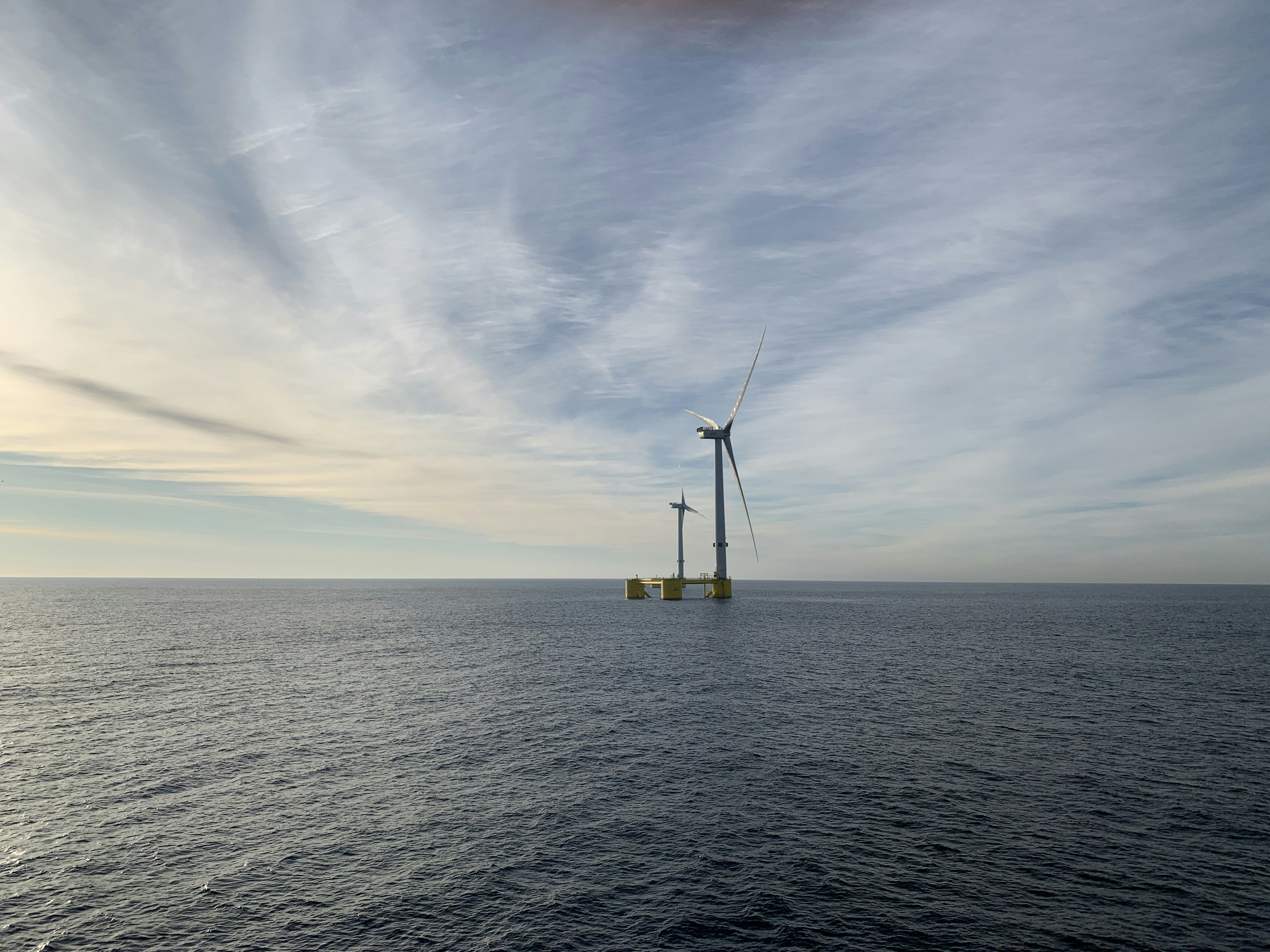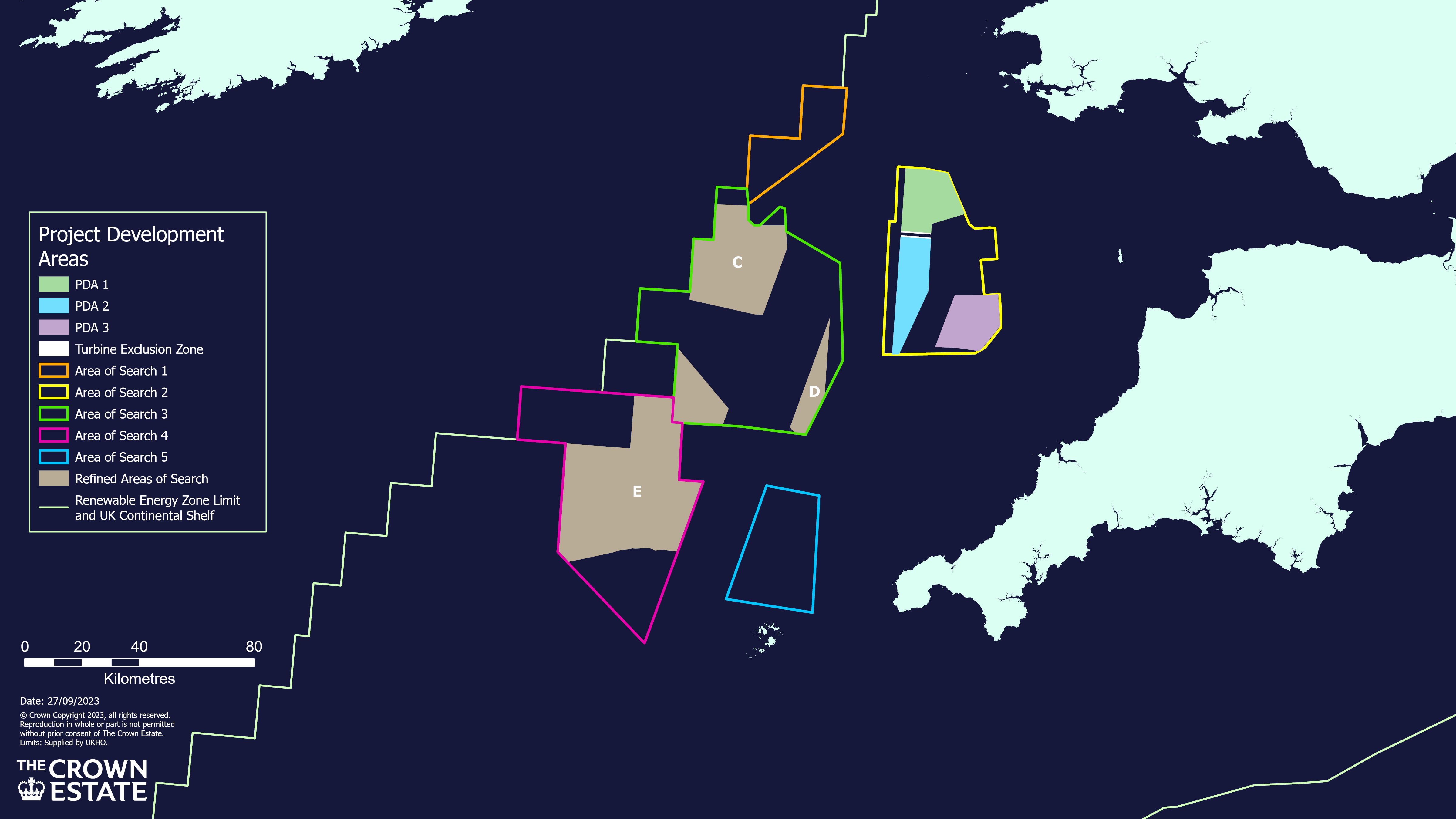
Round 5 latest update
October 2023
In 2021, The Crown Estate first set out plans to explore viable options for a potential leasing opportunity for the first commercial-scale floating wind projects to be located in the Celtic Sea off the coast of Wales and the South West of England. This will be known as Offshore Wind Leasing Round 5, and is expected to be the first phase of development in the Celtic Sea.
The Crown Estate has further refined elements of the leasing round, responding to engagement with the market following our most recent formal update in July. This valuable process has allowed us to make changes to the Round 5 offer to maximise developer flexibility, promote efficient use of the seabed and mitigate development risks.
Market Feedback That Informed This Update
In its July market update The Crown Estate explained that the Celtic Sea is subject to spatial constraints that are under the control of the UK government. As a result of these constraints, we set out how we had focused our attention on delivering Project Development Areas (PDAs) within two of the refined areas of search published in October 2022.
The Round 5 PDAs presented in July sit within an area of the seabed that has been identified and refined through extensive engagement with stakeholders including UK government, and which remains fully agreed with them.
For these reasons, following the July update we asked interested developers specific and targeted questions which were designed to assess at a high level any commercial and technical risks associated with these sites. The feedback we received was comprehensive and detailed, showing significant ambition and enthusiasm on the part of respondents.
Nevertheless, as we expected, respondents made it clear that the final PDAs need careful consideration to maximise value for the sector. A majority of respondents noted the limited spatial flexibility which could impact their ability to respond and adapt their designs to issues that could arise in development.
Points raised through our recent engagement included:
The uncertainty in this emerging market around foundation, anchoring and mooring solutions and optimal array layouts.
The potential impact of telecommunications cables within the PDAs.
The cumulative impacts of closely located projects on the environment and on other sectors like civil navigation.
The potential implications of the proximity of the PDAs on wake effects and on other users of the seabed.
Based on this feedback on the need for greater spatial flexibility given technical constraints, we have revised our minded-to position set out in July.
PDAs and Spatial Design: Update Position
Our minded-to position in July proposed to offer the market four PDAs. Following feedback, we have adapted the spatial offer to three PDAs within the same seabed area, each of which has an enhanced potential capacity of up to 1.5GW. Where previously there was scope to allow a single bidder to win two PDAs, under the revised structure, each bidder will be permitted to win one PDA.
In summary we can confirm that for Offshore Wind Leasing Round 5:
The outer boundary of the area containing the PDAs remains unchanged, as do the key minded-to technical parameters like separation distances between adjacent projects.
Round 5 will bring to market three larger PDAs, rather than four PDAs.
Up to 1.5GW could be feasible in each new PDA, providing up to 4.5GW in total, instead of the previously expected 4GW.
Each PDA will have one winner.
Development of each PDA may occur in multiple projects or phases of at least 300MW as previously advised (up to a maximum of three projects or phases).

The GIS shapefiles of our final PDAs are available here.
Explanation
By having a smaller number of larger PDAs, winning bidders will have greater spatial flexibility to adapt their detailed project designs to account for issues arising in development, both maximising the MW capacity they can deliver and reducing their risk. The decision to refocus the opportunity around three PDAs with more discretion on how the available seabed space is best used, also provides for an increase in the target capacity in each PDA.
With a smaller number of PDAs being offered, limiting a bidder to winning a single PDA both maximises opportunity for all bidders and protects long term competition in the market for future rounds of leasing.
Sharing Data with Developers
You will be aware that The Crown Estate is currently undertaking pre-consent surveys in the Celtic Sea, which will in due course provide data to developers to help them take early decisions and supporting the de-risking and acceleration of their projects. In response to industry appetite to understand more about the data we intend to share, The Crown Estate will publish the technical specifications underpinning these surveys in October. More details on the latest phase of this work is available in our news release accompanying this update.
Developers’ feedback also showed they would benefit from more information regarding wider views among key stakeholders on things like design, planning and consenting risks. The Crown Estate intends to share a range of materials that will support developers in framing their bids. Alongside the Information Memorandum, The Crown Estate will publish:
A summary characterisation report for each PDA it is bringing to market providing details on: environmental, navigation, sub-sea telecoms, fishing, civil aviation, defence, marine plans and any legacy sites uses (disposal sites), plus a short technical summary
A detailed site selection methodology
Summary of marine stakeholder engagement and associated outcomes
Holistic Network Design
The Crown Estate works closely with National Grid ESO in support of their Holistic Network Design Follow Up Exercise (HND FUE) for the Celtic Sea. Through this process we expect that Offshore Wind Leasing Round 5 bidders will have timely visibility of an ESO-recommended offshore network design that facilitates energy export from the PDAs in the most appropriate way, balancing environmental, social and economic factors.
To help expedite the HND Follow Up Exercise, we have already communicated the PDA spatial and capacity information to National Grid ESO and National Grid Electricity Transmission (NGET).
Plan-Level Habitats Regulations Assessment
Similarly, the revised spatial arrangement for the project will inform the Plan-Level Habitats Regulations Assessment (HRA) which is being undertaken alongside the tender process to generate greater momentum and investor confidence.
Following the finalisation of the spatial and capacity offering, our next step involves conducting additional assessments within the HRA framework. Subject to a successful conclusion to the HRA, this process will be completed ahead of ITT1, allowing developers to account for it in their bidding strategies.
Future Pipeline
The Crown Estate recognises that confidence in a future Celtic Sea pipeline will make Round 5 more attractive to developers in an international market and encourage further investment.
We continue to work closely with the UK government with the shared goal of delivering more certainty over the future pipeline as soon as possible. However, the Celtic Sea is a particularly busy area of seabed, and the UK government is continuing its work to resolve a number of competing demands for its use.
Further Requirements for Round 5 Bidders
The Crown Estate outlined to the market in July a range of commitments that will be required of all bidders, ensuring they play a full part in creating the early conditions for long term supply chain success and delivering on the wider economic and social opportunities arising from Round 5. Bidders will be required to show commitments for the timely use of integration ports (used for the integration of the turbine with its foundation before being towed to project sites) that are essential for assembling and deploying floating wind platforms.
Bidders will be expected to make firm and binding commitments to generating positive social impact through their activities delivering Round 5 projects, aligned to the theme of the UK government’s Social Value Model in four key areas:
Employment and training opportunities, particularly for those who face barriers to employment, and dealing with skills shortages;
Tackling inequalities in employment, skills within the workforce delivering projects;
Environmental benefits aimed at working towards net zero, protecting habitats and supporting efforts to enable the transition from carbon-intensive industries.
Working with communities to ensure that benefits are delivered in a manner that involves those communities and is sustainable over time.
Taken together, these commitments will ensure developers play their part in creating a transformative opportunity for communities and businesses in regions where Round 5 projects will be developed and delivered.
Further detail on these elements will be included in the Information Memorandum, which is expected to be published later this year.